Table 1 sets out latest (June 2020) construction-related cost items from the Producer Price Index (PPI) data set published by the Bureau of Labor Statistics (BLS).
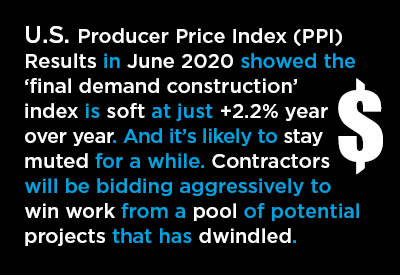
The top blue-shaded section highlights price movements over varying stretches of time, as they appear to owners undertaking projects.
The blue-shaded series are all-inclusive. They include material, labor and profit.
The unshaded section in Table 1 focuses on individual building material products (i.e., construction material inputs).
The bottom brown-shaded portion looks at the cost of inputs going into various types of structures. The inputs are weighted according to their usage in the different categories of construction.
The slowing in the general economy caused by the pandemic has lowered construction activity levels. In recent months, the pressure on prices has mostly been easing, rather than percolating more heatedly.
From Table 1, the ‘final demand construction’ index is soft at just +2.2% year over year. And it’s likely to stay muted for a while. Contractors will be bidding aggressively to win work from a pool of potential projects that has dwindled.
Table 1: U.S. Producer Price Index (PPI) Results
% Change in the June 2020 Index from:
| 3 Years | 1 Year | 6 months | 3 months | 1 month | |||||
| Ago | Ago | Ago | Ago | Ago | |||||
| Final Demand/Service/Commodity/Energy/Input: | |||||||||
| Final Demand Construction | 12.2% | 2.2% | 0.8% | 0.1% | -0.3% | ||||
| New warehouse building construction | 10.3% | 1.1% | -0.3% | -0.9% | 0.0% | ||||
| New school building construction | 13.8% | 1.8% | 0.9% | 0.0% | -0.6% | ||||
| New office building construction | 11.4% | 2.3% | 0.3% | -0.1% | -0.6% | ||||
| New industrial building construction | 15.3% | 2.9% | 1.4% | 0.9% | -0.1% | ||||
| New health care building construction | 11.9% | 2.4% | 1.2% | 0.3% | 0.0% | ||||
| Architectural & engineering services | 5.3% | 0.2% | -0.3% | -0.9% | 0.2% | ||||
| Construction machinery & equipment | 7.1% | 1.8% | 1.0% | 0.0% | 0.0% | ||||
| Asphalt | -12.8% | -39.5% | -16.9% | -27.6% | 12.3% | ||||
| Plastic construction products | 6.1% | 0.0% | 0.2% | -1.2% | -0.5% | ||||
| Softwood lumber | 10.6% | 18.6% | 11.2% | 2.4% | 11.0% | ||||
| Hardwood lumber | -8.4% | -7.1% | -1.6% | -2.1% | -0.9% | ||||
| Millwork | 8.0% | 1.5% | 1.4% | 0.2% | -0.2% | ||||
| Plywood | -1.4% | -3.2% | 1.3% | -0.7% | 0.6% | ||||
| Particle board & oriented strandboard (OSB) | -0.7% | 11.5% | 5.4% | -3.7% | 5.3% | ||||
| Gypsum | -2.5% | 0.8% | 0.3% | -1.7% | -0.3% | ||||
| Insulation materials | 4.4% | 2.1% | 1.9% | -0.3% | -0.9% | ||||
| Construction sand, gravel & crushed stone | 13.2% | 4.6% | 4.3% | 1.2% | 0.7% | ||||
| Cement | 5.4% | 0.2% | 1.3% | 1.8% | 0.9% | ||||
| Ready-mix concrete | 9.1% | 1.4% | 2.3% | -0.1% | -0.1% | ||||
| Precast concrete products | 11.1% | 2.4% | 1.2% | 0.1% | -0.4% | ||||
| Prestressed concrete products | 7.6% | 2.3% | 0.6% | 1.2% | 0.2% | ||||
| Brick (clay) | 4.6% | 1.7% | 0.6% | 0.2% | 0.0% | ||||
| Coal | -0.8% | -4.2% | -1.9% | 1.8% | -0.8% | ||||
| Iron ore | 2.7% | 0.1% | 0.2% | 0.2% | 0.0% | ||||
| Iron & steel scrap | -12.5% | -5.2% | -0.7% | -6.9% | -0.9% | ||||
| Steel bars, plates & structural shapes | 2.6% | -12.3% | -0.5% | -3.4% | -1.9% | ||||
| Steel pipe & tube | 5.0% | -7.8% | -3.7% | -5.7% | -3.6% | ||||
| Fabricated structural metal products | 9.5% | 0.2% | 1.3% | 0.5% | 0.5% | ||||
| Prefabricated Metal Buildings | 8.6% | -0.9% | 2.3% | -0.2% | 0.2% | ||||
| Aluminum mill shapes | -5.5% | -14.5% | -11.3% | -8.7% | -0.4% | ||||
| Flat glass | 5.0% | 1.8% | 1.4% | 0.2% | 0.4% | ||||
| Paints, architectural coatings | 14.2% | 0.9% | 0.3% | 0.6% | 0.1% | ||||
| Lighting fixtures | 10.0% | 2.2% | 0.8% | 0.2% | 0.2% | ||||
| Plumbing fixtures & fittings | 6.8% | -0.2% | -1.2% | -2.4% | -2.6% | ||||
| Elevators & escalators | 8.7% | 1.2% | 0.9% | 0.0% | 0.0% | ||||
| Heating equipment | 11.5% | 2.0% | 0.5% | 0.9% | 0.1% | ||||
| Air conditioning equipment | 10.5% | 1.7% | 1.4% | 1.9% | 0.6% | ||||
| Copper wire & cable | 8.4% | 0.1% | -1.2% | 0.5% | 0.0% | ||||
| Regular gasoline unleaded | -23.2% | -36.7% | -29.0% | -12.5% | 24.9% | ||||
| Diesel Fuel | -19.6% | -32.5% | -40.3% | -19.6% | 27.3% | ||||
| Inputs to new construction | 6.0% | -1.5% | -1.6% | -1.4% | 0.9% | ||||
| Inputs to new residential construction | 6.2% | -0.8% | -1.0% | -1.3% | 0.8% | ||||
| Inputs to new non-res construction | 6.0% | -2.0% | -2.1% | -1.3% | 1.2% | ||||
| Inputs to commercial construction | 6.4% | -1.8% | -1.9% | -1.3% | 0.9% | ||||
| Inputs to healthcare structures | 6.3% | -1.4% | -1.5% | -1.1% | 0.8% | ||||
| Inputs to industrial structures | 6.8% | -1.8% | -2.3% | -1.4% | 0.5% | ||||
| Inputs to highways & streets | 5.2% | -3.5% | -3.3% | -2.1% | 1.6% | ||||
| Inputs to power & communication structures | 4.8% | -2.9% | -2.8% | -1.6% | 1.3% | ||||
| Inputs to educational & vocational structures | 6.8% | -0.9% | -1.3% | -1.1% | 0.8% | ||||
| Construction materials (PPI ‘Special Index’) | 5.9% | -0.5% | 1.2% | -0.5% | 0.9% |
The ‘final demand’ indices (at top) reflect the prices paid by owners for the construction of projects. They include material, labor & markups.
The ‘service’, ‘commodity’ and ‘energy’ indices (in the middle section of the table) are based on ‘factory-gate’ sales prices.
The ‘input’ indices (at bottom) reflect costs faced by contractors. They exclude capital investment (i.e., machinery & equipment), labor & imports.
The ‘input’ indices are built up from the ‘service’ (design, legal, transport & warehousing, etc.) ‘commodity’ and ‘energy’ indices.
Data source: Producer Price Index (PPI) series from Bureau of Labor Statistics (BLS).
Table: ConstructConnect.
Forestry Prices Higher; Steel, Aluminum & Energy Prices Lower
Notable year-over-year price changes (high to low) among building product inputs have been as follows:
- Softwood lumber, +18.6% year over year (y/y) (and +11.0% month over month (m/m));
- Particle board and oriented strandboard (OSB), +11.5% y/y (and +5.3% m/m);
- Sand, gravel and crushed stone, +4.6% y/y;
- Iron and steel scrap, -5.2% y/y (and -6.9% over latest three months);
- Steel pipe and tube, -7.8% y/y;
- Steel bars, plates and structural shapes, -12.3%;
- Aluminum mill shapes, -14.5%;
- Diesel fuel, -32.5% y/y (but +27.3% m/m);
- Gasoline, -36.7% y/y (but +24.9% m/m);
- Asphalt, -39.5% y/y (but +12.3% m/m).
Notice that in the above listing of ten items, only three are higher y/y, while seven are lower.
Coronavirus-related Reasons for Price Changes
The forestry product increases have resulted from supply reductions and demand increases. Anticipating that spring’s huge job losses would mean fewer housing starts, owners of sawmills shut down operations. What they didn’t foresee, though, was an upsurge in home renovation and backyard improvement projects being undertaken by families taking stay-at-home vacations this summer (a.k.a., ‘staycations’).
The steel price drops reflect excess world production capacity at a time when gross domestic product (GDP) levels in nearly every country have come under COVID-19-related stress. The same goes for aluminum, although it is facing an additional negative tied to the precipitous plunge in world travel. The market for new airplanes has disappeared overnight.
Interestingly, though, with restaurant dining on the wane and stockpiling of groceries at home becoming more common, a shortage of aluminum for beverage cans has developed.
The gasoline and diesel fuel price drops correlate with the global price of oil, which at one point this spring fell below zero U.S. dollars per barrel. The month-to-month gains arise from the international price of crude recovering back above $40 USD per barrel.
Inputs to New Construction -1.5% Y/Y
From the bottom brown-shaded section of Table 1, the ‘inputs to new construction’ index in June was -1.5%. With some uplift provided by lumber prices, the decline in the ‘inputs to new residential construction’ index, at -0.8% y/y, was less than for the ‘new nonresidential construction’ index, -2.0% y/y.
Among types of structures, the ‘inputs to highways and streets’ index recorded the sharpest contraction, -3.5% y/y, although it was +1.6% m/m. Again, it was the price of oil (and asphalt) that played a key role in establishing that down-and-up pattern.
Set out below are graphs showing the histories, since January 2000, of the PPI series for 20 building products. For only a limited number of them can it be said that the curves have been consistently rising over the past 20 years ‒ ‘sand, gravel and crushed stone’, ‘ready-mix concrete’, ‘fabricated structural metal products’, ‘flat glass’ and ‘insulation materials’.
Panel 1 – Forestry Products & Gypsum
U.S. Contstruction Material Costs – From Producer Price Index (PPI) Series
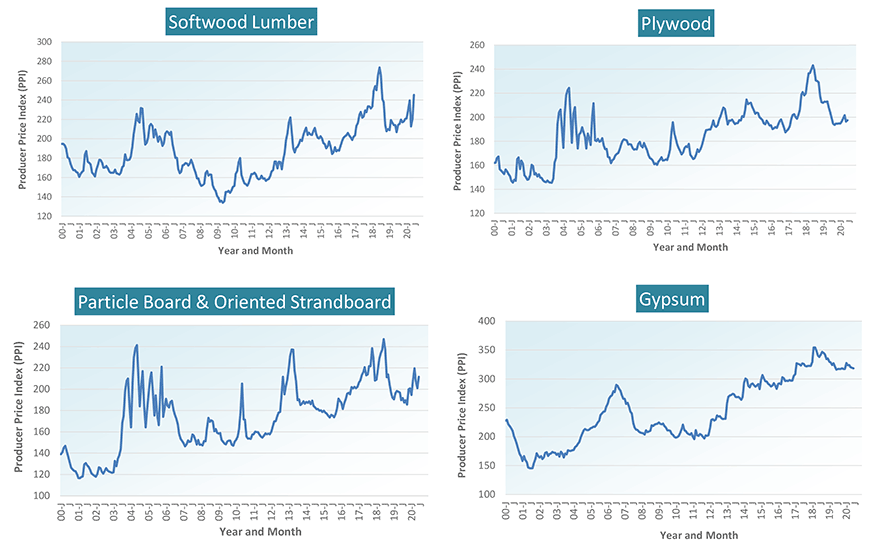
The last data point is June, 2020.
Data source: U.S. Bureau of Labor Statistics (BLS), Producer Price Index (PPI) series, not seasonally adjusted (NSA).
Charts: ConstructConnect.
Panel 2 – Cement- and Brick-Related
U.S. Contstruction Material Costs – From Producer Price Index (PPI) Series
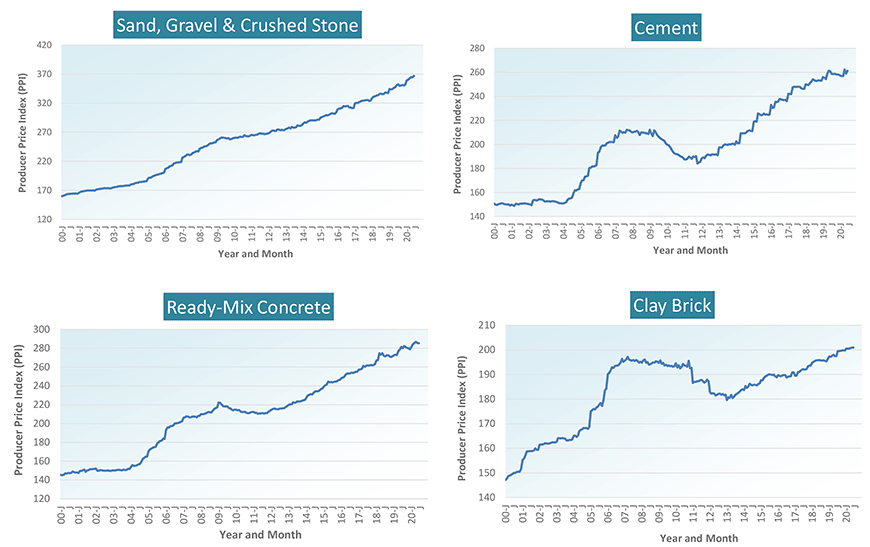
The last data point is June, 2020.
Data source: U.S. Bureau of Labor Statistics (BLS), Producer Price Index (PPI) series, not seasonally adjusted (NSA).
Charts: ConstructConnect.
Panel 3 – Steel-Related
U.S. Contstruction Material Costs – From Producer Price Index (PPI) Series
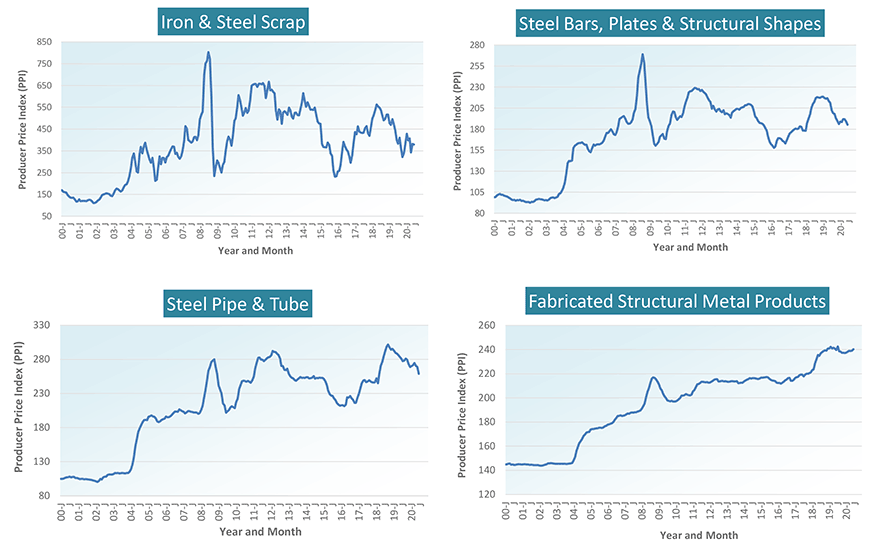
The last data point is June, 2020.
Data source: U.S. Bureau of Labor Statistics (BLS), Producer Price Index (PPI) series, not seasonally adjusted (NSA).
Charts: ConstructConnect.
Panel 4 – Base Materials (1)
U.S. Contstruction Material Costs – From Producer Price Index (PPI) Series
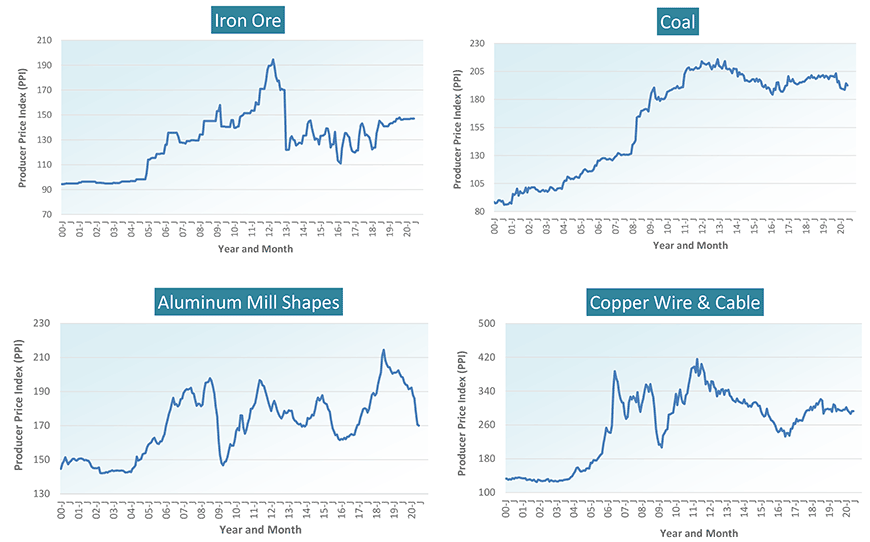
The last data point is June, 2020.
Data source: U.S. Bureau of Labor Statistics (BLS), Producer Price Index (PPI) series, not seasonally adjusted (NSA).
Charts: ConstructConnect.
Panel 5 – Base Materials (1)
U.S. Contstruction Material Costs – From Producer Price Index (PPI) Series
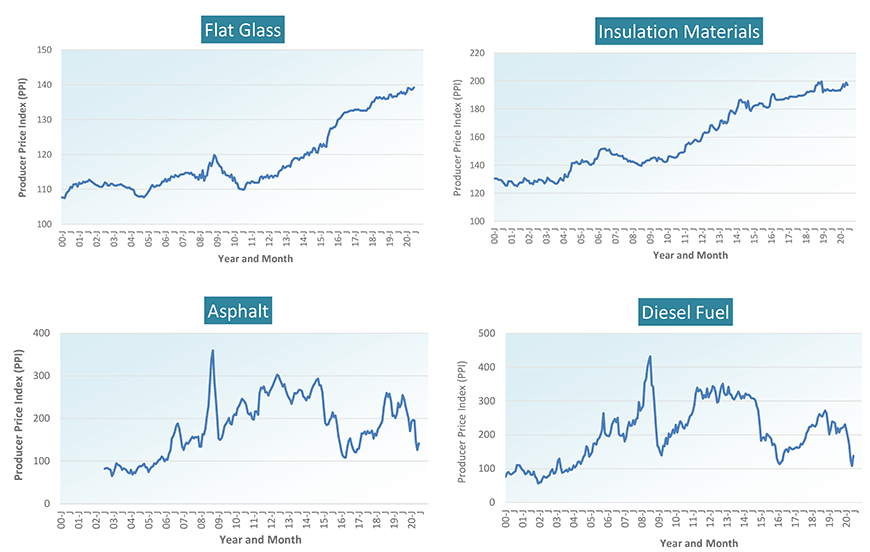
The last data point is June, 2020.
Data source: U.S. Bureau of Labor Statistics (BLS), Producer Price Index (PPI) series, not seasonally adjusted (NSA).
Charts: ConstructConnect.
Alex Carrick is Chief Economist for ConstructConnect. He has delivered presentations throughout North America on the U.S., Canadian and world construction outlooks. Mr. Carrick has been with the company since 1985. Links to his numerous articles are featured on Twitter @ConstructConnx, which has 50,000 followers.
"soft" - Google News
July 23, 2020 at 10:35PM
https://ift.tt/32NuIEv
US Producer Price Index (PPI) for Construction Soft in June, +2.2% Y/Y - Daily Commercial News
"soft" - Google News
https://ift.tt/2QZtiPM
https://ift.tt/2KTtFc8
Bagikan Berita Ini














0 Response to "US Producer Price Index (PPI) for Construction Soft in June, +2.2% Y/Y - Daily Commercial News"
Post a Comment